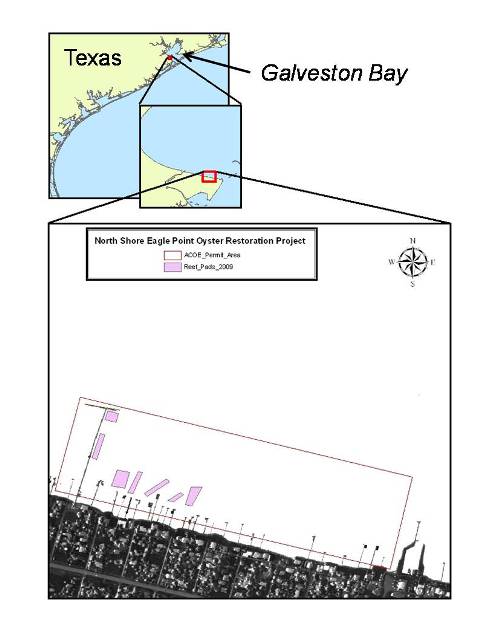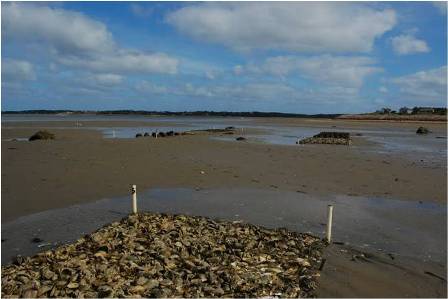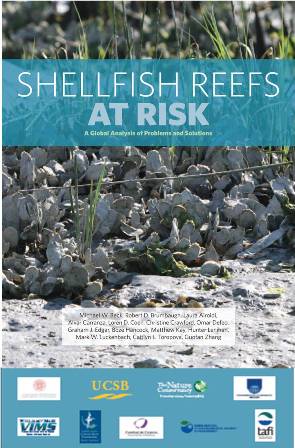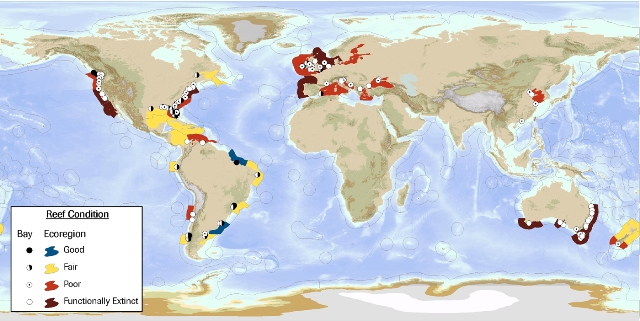|
|

|
|
River rock and
crushed concrete were used to create the foundations of restored oyster
reefs in Galveston Bay. The rock has proved quite useful for
attracting settlement of new oysters.
Photo: TPWD
|
In September,
barges began unloading crushed concrete and river rock as oyster substrate
(‘cultch’) in several parts of Galveston Bay, Texas, to help revive oyster
reefs that had been damaged by Hurricanes Rita (2005) and Ike (2008). The
Texas Parks and Wildlife Department (TPWD) is spearheading a multi-faceted
restoration effort that is designed to achieve two different sets of
management objectives. In East Galveston Bay, where approximately 80% of
reefs were destroyed by Hurricane Ike, approximately 20 acres of reef have
been constructed with future harvest in mind to benefit the region’s
commercial oyster industry. The restored reefs will be set aside for two
years and allowed to accumulate oysters prior to being opened for harvest.
Importantly, the restoration effort is accompanied by a monitoring program
using side-scan sonar and a scientific echosounder to characterize the
reefs themselves as well as the fish assemblage occurring over the reefs.
In another part of
the bay, a project jointly funded by the TPWD, U.S. Fish and Wildlife
Service and the Galveston Bay Foundation is being implemented with a
different management objective in mind – restoring oyster reefs to provide
habitat for fish. This, in turn, is aimed at improving recreational angling
opportunities along the Bay’s western shoreline. Patches of reef habitat
are being restored within an area that is currently closed to commercial
and recreational oyster harvesting because of water quality restrictions.
Recreationally important fish species will benefit from the increase in
reef habitat in this area, however, enabling managers to create new
opportunities for recreational anglers to catch highly prized species such
as spotted seatrout and red drum (redfish) along the western shoreline of
Galveston Bay. There is direct public participation in the project as well
that will both enhance the reefs and increase awareness of, and support
for, active oyster reef habitat restoration. Homeowners with piers on
nearby shorelines are suspending bags of shell in the bay to attract
juvenile oysters (spat). The captured oysters will be transferred to the
newly constructed reef to help ‘jump start’ the population and to augment
the numbers of oysters that will settle naturally on the reefs.
|

|
|
Reefs designed
to attract recreational fish were created in the western portion of Galveston
Bay. Map: TPWD
|
Check out the Cool
Video Clip below for more information about the project!
Contacts: Bill
Rodney bill.rodney@tpwd.state.tx.us
or Jennie Rohrer jennie.rohrer@tpwd.state.tx.us
Back to top »
The Nature Conservancy of Massachusetts is working with
MassAudubon, the Town of Wellfleet and NOAA’s Restoration Center to revive
a natural oyster reef in Wellfleet Bay, off of Lieutenant Island on MassAudubon’s
Wellfleet Bay Sanctuary intertidal property. Working with a broad
advisory group made up of local shellfishermen, the town shellfish
constable, and Cape Cod Cooperative Extension, the project team is working
to promote Eastern oyster reefs for their value as important coastal
habitat, not just as a fishery commodity more famously known on restaurant
menus as “Wellfleets”. Oysters appear to be limited in the bay by a lack of
settlement habitat, so with guidance from the advisory group and the
Massachusetts Division of Marine Fisheries, the project is designed to test
the viability of three different oyster reef substrates: hollow cement
structures called ‘oyster castles’, hollow cement ‘reef balls’ and more
traditional surf clam and oyster shell cultch. The project was funded by
the National Partnership between The Nature Conservancy and NOAA’s
Community-based Restoration Program.
Surf clam shell was deployed as oyster settlement
substrate in June 2008 to confirm the ability of the site to attract
larvae, and plots containing the full array of three major substrates were
established this past June. The site will be monitored for a minimum of
three years and the data will help to inform recommendations for a
sustainable Experimental Harvest Plan for portions of the reef site when
oysters grow to legal size.
The project team also continues to work with the
Massachusetts Division of Marine Fisheries and other agencies on
longer-term questions about sustainable harvest, appropriate restoration
techniques and the development of a submerged lands leasing program to
better protect shellfish restoration investments. For more information, Contact:
Kate Killerlain Morrison kkmorrison@tnc.org.
|

|
|
Different kinds
of oyster settlement substrate, or ‘cultch’, are being tested as a
material for intertidal oyster restoration in Wellfleet Bay.
Credit: Mark Faherty, Mass Audubon.
|
Back to top »
Aquaculture
2010: National Shellfisheries Association / Triennial Meeting
March 1-5
San Diego, California.
Save the Date: 5th National
Conference on Coastal and Estuarine Restoration
Conference theme: “Preparing for climate change: science, practice and
policy”.
November 13-17, 2010
Galveston, Texas
Note: If you would
like to contribute an article or submit items for the "Looking
Ahead" section, please contact Rob Brumbaugh (rbrumbaugh@tnc.org)
Back to top »
The Practitioner’s
Guide to Shellfish Restoration: An Ecosystem Services Approach,
as well as back issues of the Shellfish
Restoration Clamor are available online.
Guidance on methods for monitoring oyster reef
restoration projects is available at the Oyster Restoration Workgroup website.
Cool
Video!
Texas Parks and Wildlife Department’s video describing the recent oyster
reef restoration activities in Galveston Bay.
Back to top »
|









